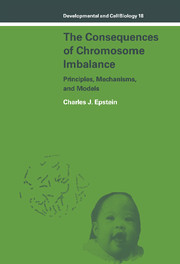Book contents
- Frontmatter
- Contents
- Preface
- Glossary
- PART I INTRODUCTION
- PART II CLINICAL OBSERVATIONS
- PART III THE THEORETICAL MECHANISMS AND ISSUES: THE PRIMARY AND SECONDARY EFFECTS OF ANEUPLOIDY
- PART IV EXPERIMENTAL SYSTEMS FOR THE STUDY OF MAMMALIAN AND HUMAN ANEUPLOIDY
- PART V THREE MAJOR CLINICAL PROBLEMS OF HUMAN ANEUPLOIDY
- 12 Trisomy 21 (Down syndrome)
- 13 Monosomy X (Turner syndrome, gonadal dysgenesis)
- 14 Cancer
- PART VI CONCLUSION
- Appendix: Standard karyotypes of man and mouse and human cytogenetic nomenclature
- References
- Index
12 - Trisomy 21 (Down syndrome)
Published online by Cambridge University Press: 14 October 2009
- Frontmatter
- Contents
- Preface
- Glossary
- PART I INTRODUCTION
- PART II CLINICAL OBSERVATIONS
- PART III THE THEORETICAL MECHANISMS AND ISSUES: THE PRIMARY AND SECONDARY EFFECTS OF ANEUPLOIDY
- PART IV EXPERIMENTAL SYSTEMS FOR THE STUDY OF MAMMALIAN AND HUMAN ANEUPLOIDY
- PART V THREE MAJOR CLINICAL PROBLEMS OF HUMAN ANEUPLOIDY
- 12 Trisomy 21 (Down syndrome)
- 13 Monosomy X (Turner syndrome, gonadal dysgenesis)
- 14 Cancer
- PART VI CONCLUSION
- Appendix: Standard karyotypes of man and mouse and human cytogenetic nomenclature
- References
- Index
Summary
Having presented a detailed review of both the theoretical and experimental aspects of our current understanding of aneuploidy, I now turn to a consideration of three important human clinical problems associated with aneuploidy. Two of these are specific disorders caused by chromosome imbalance: trisomy 21, with its phenotype of Down syndrome, and monosomy X (or XO), with its phenotype of Turner syndrome or gonadal dysgenesis. The third problem is not a single genetic disorder, but, rather, a whole group of acquired disorders in which aneuploidy appears to play a significant but poorly understood role – cancer. For the first two conditions, the intent, once again, is to focus on questions of mechanism and to relate what is known about the chromosomes involved to the phenotypes that are observed. If it is not possible to make such connections, the discussion will point up those issues which appear to offer the most with regard to arriving at mechanistic solutions.
The discussion of trisomy 21 in this chapter will begin with what is known about the genetic structure of human chromosome 21. It will proceed to consideration of first the implications of the imbalance of loci known to be on the chromosome and then of those aspects of Down syndrome the relation of which to imbalance of loci on chromosome 21 is not presently apparent. Finally, a newly developed animal model system for trisomy 21 will be discussed.
- Type
- Chapter
- Information
- The Consequences of Chromosome ImbalancePrinciples, Mechanisms, and Models, pp. 253 - 323Publisher: Cambridge University PressPrint publication year: 1986
- 5
- Cited by



